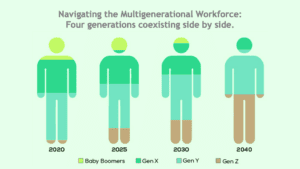Navigating the Multigenerational Workforce: Four generations coexisting side by side.
In today’s workforce, we are witnessing a historic phenomenon—four generations coexisting side by side. From baby boomers to Generation X, millennials, and the first wave of Generation Z, businesses are now faced with the challenge of managing a diverse multi-generational workforce. With employees spanning a wide age range, it is crucial for organisations to adapt their management styles to effectively engage and motivate each generation. This article explores the implications of this unprecedented age gap and highlights the importance of leveraging the strengths of each generation to foster collaboration and success.
Understanding the Age Gap:
According to human resources experts, the presence of four generations in the workforce is a significant departure from past norms. Dalhousie University professor Eddy Ng notes that managing such a diverse workforce can be challenging due to the different values and expectations held by each generation. Company policies, largely shaped by baby boomers’ work style, are now being disrupted by the arrival of millennials, who have introduced new demands such as flexible work arrangements.
The Changing Landscape:
As the oldest millennials approach their late 30s, they are joined by members of Generation Z in the workplace. This cultural dynamic, combined with a wide age range, has a profound impact on communication, motivation, and work preferences. Bruce Mayhew, a human resources consultant, highlights how the experiences of previous generations, such as layoffs during globalisation, have shaped the mindset of Gen Xers and older millennials, leading to a more fluid approach to job loyalty and a willingness to seek new opportunities.
Differing Perspectives on Loyalty:
Boomers, who experienced a working environment where loyalty and career advancement were paramount, have historically shared similar aspirations. However, the younger generations have witnessed their parents’ job disruptions and have adopted a more transient approach to employment. Gen Xers and millennials are more likely to switch jobs in pursuit of better opportunities, while placing a greater emphasis on work-life balance and personal fulfilment.
Adapting to Changing Expectations:
Employers must recognise and address the shifting values and expectations of younger generations. Aiman Attar, a recruiter in the real estate industry, notes that millennials prioritise work-life balance and remote work options. As a result, companies need to adjust their management practices and re-educate themselves on client expectations. Similarly, younger employees may have shorter tenures in specific roles, seeking new challenges and personal growth opportunities.
Embracing Purpose and Collaboration:
Carly Silberstein, CEO of Redstone Agency, emphasises that younger generations are motivated by a sense of purpose and a desire to contribute to something larger than themselves. To attract and retain talent, organisations must keep this motivation in mind and provide opportunities for meaningful work. Additionally, successful collaboration across generations requires open-mindedness and the recognition that each generation brings unique skills and expertise to the table.
Harnessing Collective Knowledge:
Rather than focusing solely on knowledge transfer from older to younger workers, managers should encourage knowledge exchange among different generations. This includes leveraging the technical skills of younger employees while tapping into the industry knowledge and wisdom of older workers. By creating an environment that values and promotes cross-generational learning, organisations can maximise the collective strengths and create a culture of continuous growth.
Conclusion:
The presence of four generations in the contemporary workforce presents both challenges and opportunities for organisations. By recognising and respecting the diverse values, expectations, and motivations of each generation, businesses can create a harmonious work environment that leverages the unique contributions of all employees. Embracing flexibility, promoting purpose-driven work, and fostering intergenerational knowledge exchange are key to unlocking the full potential of a multigenerational workforce. As businesses navigate this unprecedented age gap, they have the chance to build a dynamic and inclusive workplace that thrives on collective strengths and paves the way for future success.


